Switching/switch from puppy to adult dog food is a pivotal aspect of caring for your growing canine companion. Welcoming a new puppy into your family brings thrilling and happy moments, marked by their lively behaviors and adorable puppy eyes. As your pet matures, understanding the timing and process of transitioning to adult dog food becomes essential. This guide delves into the crucial considerations, emphasizing the importance of recognizing your dog’s life stages and varying nutritional needs. From the rapid growth during the first year to breed-specific differences, it provides valuable advice to ensure a seamless transition, laying the foundation for a long and happy life for your cherished pet.
Switch From Puppy to Adult Dog Food By observing Breed Size
Understanding the right time to switch from puppy to adult food is important when it comes to puppy nutrition, and this depends on the breed’s size.

Small breeds, which are distinguished by their small height, usually reach maturity earlier than larger types. It is normally advised to start the transition to adult dog food for our tiny friends at approximately 9 to 12 months of age. This early change is in line with tiny breeds’ rapid growth and development, guaranteeing that their nutritional requirements are satisfied at this critical moment.
On the other hand, dog breeds that range in size from medium to giant show a longer growth trajectory. Bigger breeds frequently carry on developing for up to 18 months or even longer. For medium to big breeds, the switch to adult dog food should happen more gradually because of this lengthy growth stage. Starting the transition between the ages of 12 and 24 months is usually advised, depending on the breed and its particular growth trends.
Pet owners may better meet the unique dietary needs of larger dogs by providing for this longer transition window, which will promote the dogs’ general health and well-being as they grow through their developmental stages.
Body Condition and Weight
Maintaining a regular check on your dog’s weight and physical state is crucial to providing appropriate pet care. Dogs’ weight fluctuates much like it does for humans, therefore it’s important to keep their bodies in good shape for their general well-being.
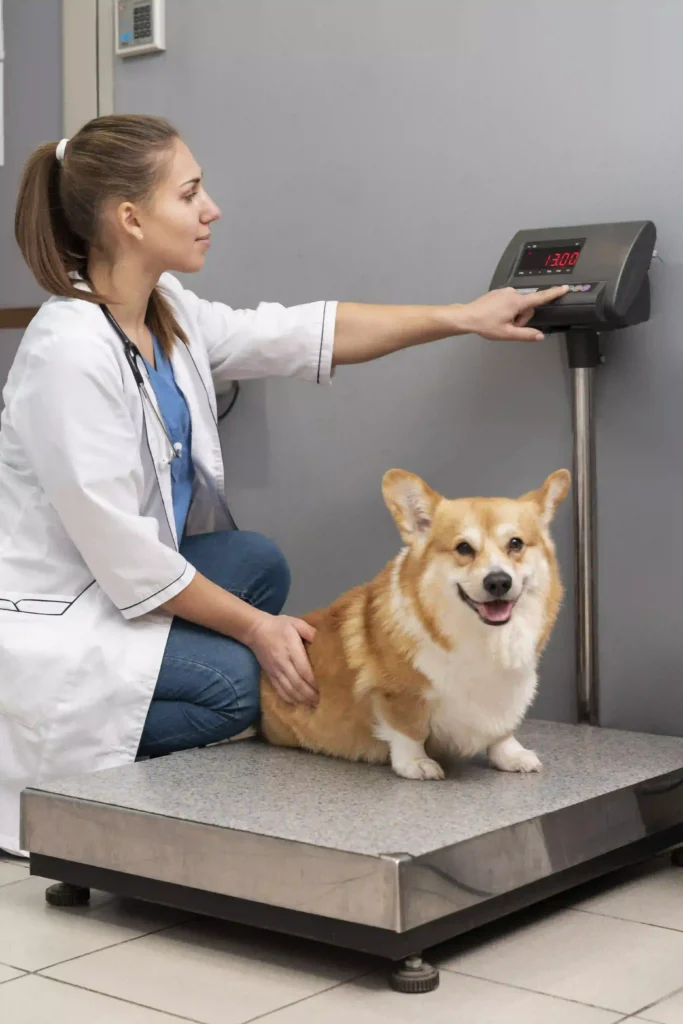
Taking into account the switch from puppy to adult dog food, paying close attention to your dog’s weight becomes very important. A healthy weight and well-defined muscles are signs of appropriate growth and development in a well-fed puppy. Regular evaluations are essential for pet owners to make sure their dog is developing as it should and to spot any possible issues with undernourishment or overfeeding.
The best time to switch your puppy to adult dog food can also be determined by keeping an eye on their weight. One good sign that your pet is ready for the nutritional transition is if it continues to maintain a stable and healthy weight. This result is consistent with the idea that a puppy that has been fed and nourished properly will have the ideal ratio of muscle to fat on its body. To meet their dog’s nutritional demands at every stage of life, pet owners may make educated decisions on when to make the switch thanks to this thorough monitoring.
To put it simply, keeping an eye on your dog’s weight and physical state is an important way to support their long-term health and vitality.
Nutritional Requirements
Your dog’s health and longevity must recognize and satisfy their nutritional needs. Puppies’ nutritional needs vary significantly as they mature and grow into maturity. Dogs that are adults have different dietary requirements than puppies. Making the transition from puppy to adult dog food is essential to making sure these needs are sufficiently satisfied. Formulations for adult dog food are carefully crafted to meet the unique requirements of mature dogs, providing optimal amounts of vital nutrients to enhance their general well-being, defenses against illness, and vitality. Take into consideration the following elements to emphasize the differences in dietary needs between puppies and adult dogs:
- Protein Levels Compared to puppy food, adult dog chow usually has moderate to slightly decreased protein levels.
- Fat Content Due to adult dogs’ lower calorie requirements, dog food may have a significantly lower fat content.
- Ratios of Calcium and Phosphorus Adult dog food keeps the ratios of calcium and phosphorus in check for healthy bones, without going overboard as is required for puppy growth.
- Caloric Density To reflect senior dogs’ lower energy expenditure, adult dog food formulas frequently modify caloric density.
- Antioxidants and Vitamins To enhance immune system performance and general health, adult dog chow is fortified with antioxidants and vitamins.
The shift to adult dog food is distinguished by an emphasis on sustaining ideal body composition and encouraging lifespan. Puppies’ energy requirements, metabolism, and food requirements change as they get older. These considerations are made in the formulation of adult dog food, which offers a suitable ratio of carbs, proteins, fats, vitamins, and minerals. This thoughtful formulation supports healthy skin and coat, maintains muscular mass, and supports the many physiological processes associated with maturation.
Gradual Transition
A gradual transition from puppy food to adult dog food is essential to facilitating a seamless changeover and reducing the possibility of gastrointestinal distress.
A dog’s digestive system may become upset by sudden dietary changes, which could cause discomfort and gastrointestinal problems. It is best to start the changeover gradually over 7–10 days to allay these worries. By introducing the food gradually, you can help your puppy’s digestive system adjust to the new diet, making the transition easier and lowering the risk of any negative responses.
Your puppy’s current diet should be gradually mixed with small amounts of adult dog food as part of the gradual transition procedure. To do this, start with a small amount of adult food and progressively add more, all the while reducing the amount of puppy food in each meal. Your puppy’s taste buds and digestive system can gradually adjust to the new diet thanks to this progressive adjustment. It is critical to observe your puppy’s behavior during this transition time to spot any indications of sensitivity or intolerance. This will allow you to modify the transition plan as needed, protecting your puppy’s welfare all along the way.
You can give your puppy the freedom to adapt to the new diet at their own pace by using a gradual and gentle transition strategy. By using this technique, the likelihood of stomach problems is reduced and a favorable association with adult dog food is promoted. In the end, a more gradual change in food results in a more seamless transition and benefits your puppy’s health and happiness as they start their trip to adulthood.
See our latest blog on “Complete Dog Training Guide: From Basics to Advanced Techniques“.
Observe Digestive Health
It’s critical to keep a close eye on your puppy’s digestive health during the critical period of switching to adult dog food. Dogs can be sensitive to dietary changes, so it’s important to watch how they respond so you can take preventative measures against any possible problems.
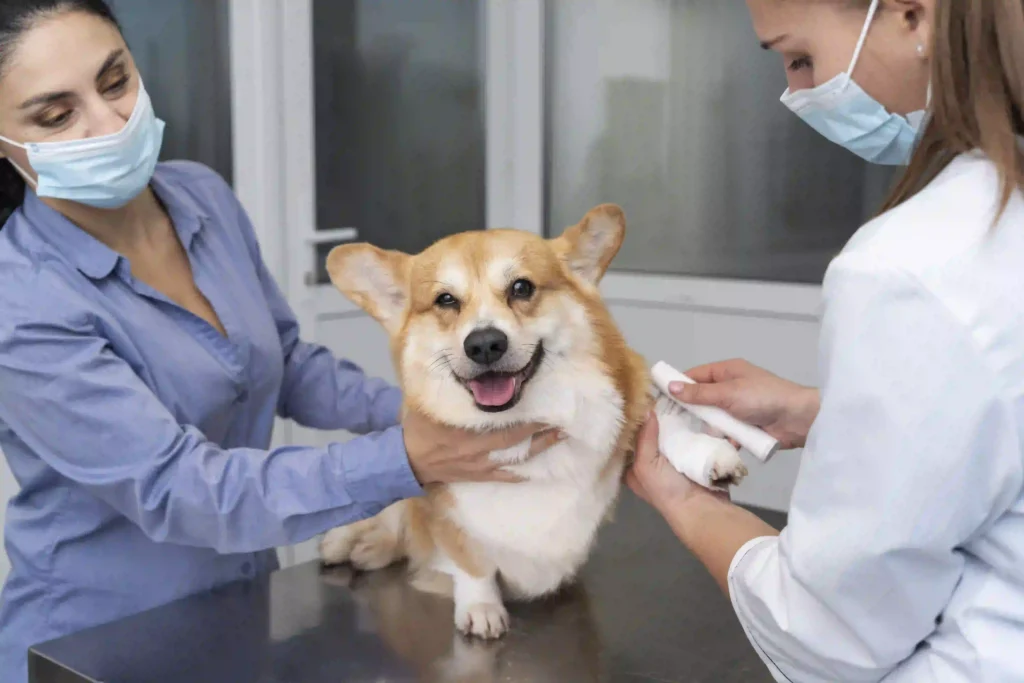
A digestive disturbance may be indicated by symptoms like diarrhea, vomiting, or changes in appetite, so be aware of these. You may learn a lot about how well your dog is adjusting to the new diet by paying close attention to their behavior and physical needs. This will allow you to respond quickly to ensure your dog’s comfort and well-being.
It’s critical to act quickly if you notice any indications of discomfort or anomalies in the digestive system. A gradual transition has several benefits, chief among which is that it gives you the chance to identify and handle any negative reactions early on. It’s best to ease up on the changeover process if your dog throws up or has diarrhea. This could mean sticking to the present adult-to-puppy food ratio for an extended period, or even going back to the original puppy diet for a brief period. Personalized and flexible transition velocity adjustments can be made following your dog’s response, taking into account their particular digestive sensitivities.
You can help ensure that your dog has a smooth and happy transition by keeping a close eye on his digestive system and acting appropriately when he shows any symptoms of difficulty. The aim is to make sure your dog’s transition to adult dog food is as easy on their digestive system as possible, so they may enjoy a smooth and healthy move to the next phase of their nutritional path.
Hydration is Key
Keeping your pet well hydrated during the shift from puppy to adult food is an important factor to take into account. Like people, dogs need to consume enough water for a variety of body processes, and this is particularly crucial when their diet changes.
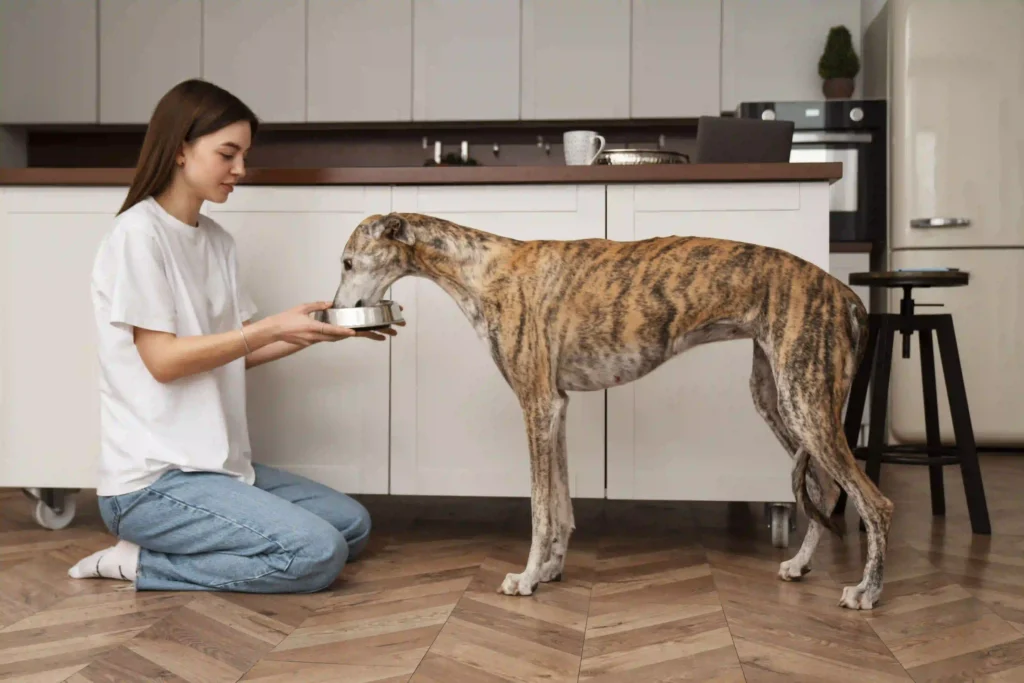
Sometimes a dog’s food can affect how much water they drink, so it’s important to monitor their water intake to maintain general health and well-being. Consistent water consumption by your dog not only facilitates better digestion but also helps avert problems that could occur when he or she is adjusting to a new diet.
A dog’s thirst patterns may change as a result of dietary changes, such as switching to adult dog food. While some dogs might drink more water, others might become less interested in doing so. Keeping an eye on your dog’s water intake during this transitional phase guarantees that they stay well hydrated and offers insightful information about their general health. To encourage your dog to drink, think about putting water dishes in convenient places and refilling them frequently. You may help support their digestive health and lessen the possibility of any negative effects from the food change by aggressively encouraging them to stay hydrated.
It’s important to speak with your veterinarian if you see any noticeable changes in your dog’s water intake or if you think they may be dehydrated. Treating dehydration early on can guarantee your dog’s continuing health and well-being as it can cause a variety of health problems. As you support your dog’s digestive health and ease their transition to adult dog food, you are also actively contributing to their holistic care by emphasizing hydration as a crucial component of the transition process.
See our latest blog on “Why are Puppies So Cute? What Science Tells Us“.
Consulting Your Veterinarian
It’s a good idea to make an appointment with your veterinarian before switching your dog from puppy to adult food.
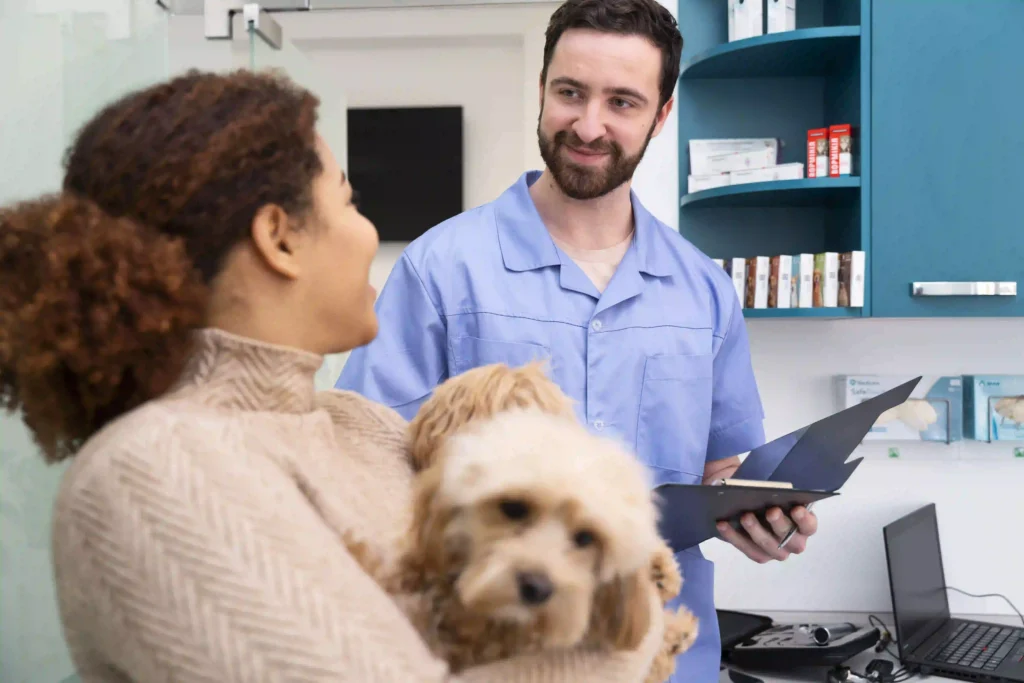
Consulting a professional will guarantee that the nutritional change is in line with your dog’s unique requirements, health, and breed traits. Veterinarians are qualified to provide individualized guidance based on your dog’s particular needs, including variables like size, age, exercise level, and any underlying medical issues.
You can talk about the best time to make the switch, the right amount of adult food to puppy food, and any unique dietary needs your dog might have at the vet visit. Because different breeds may have different nutritional needs, veterinarians can also offer insight into potential breed-specific nutritional requirements. By using a customized approach, you can make knowledgeable decisions regarding the transition and guarantee that your dog is receiving the proper ratio of nutrients to maintain their general health and well-being.
A veterinarian may handle food issues as well as do a thorough health evaluation that takes other aspects of health into account. By taking a comprehensive approach, it is possible to identify any underlying health problems that might affect your dog’s ability to make the move to adult dog food smoothly. You and your veterinarian form a cooperative collaboration that supports your dog’s long-term health and happiness by keeping lines of communication open.
Conclusion
A critical component of good pet ownership is understanding when and how to transition your dog from puppy to adult food. You may make an informed choice by taking into account variables such as breed size, weight, health, and dietary needs. To develop a customized feeding schedule that suits your pet’s specific requirements, always speak with your veterinarian. Ensuring a seamless transition is crucial to your dog’s continued well-being and contented existence.

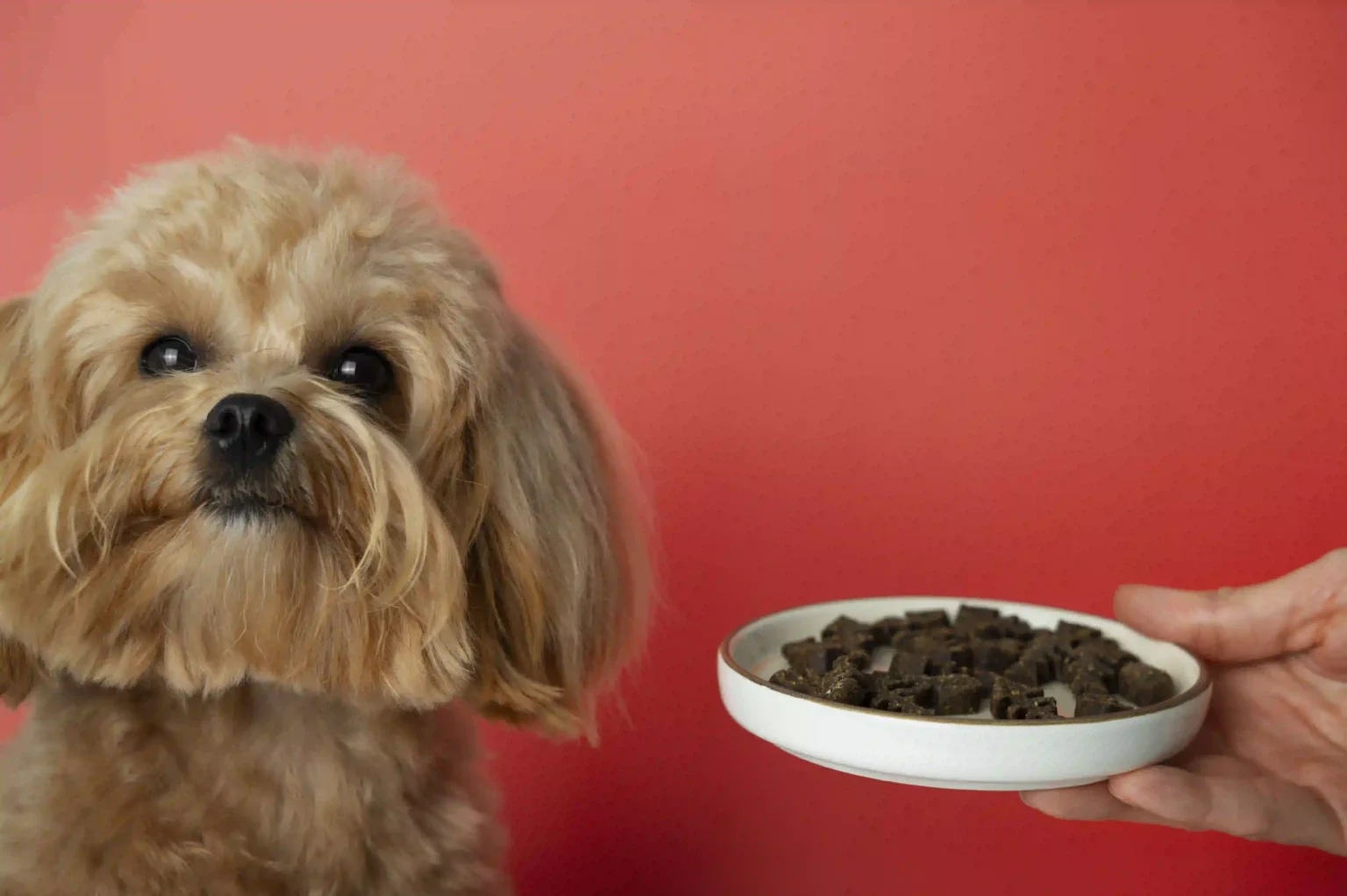

Why do people keep pets, the advantages of pets.
what to consider when choosing a pet, which pet breed is right for you.How to properly care for pets, how to create a pet’s diet.what you didn’t know about pets, why people adore pets.How to teach pets commands, how to teach a parrot to talk.
are chickens domestic animals [url=http://petstorepetsupply.com/index.php/2024/06/19/seasonal-gardening-tips/]http://petstorepetsupply.com/index.php/2024/06/19/seasonal-gardening-tips/[/url] .
I just like the valuable info you supply in your articles. I will bookmark your blog and take a look at again here regularly. I’m fairly sure I will be told a lot of new stuff right right here! Best of luck for the following!